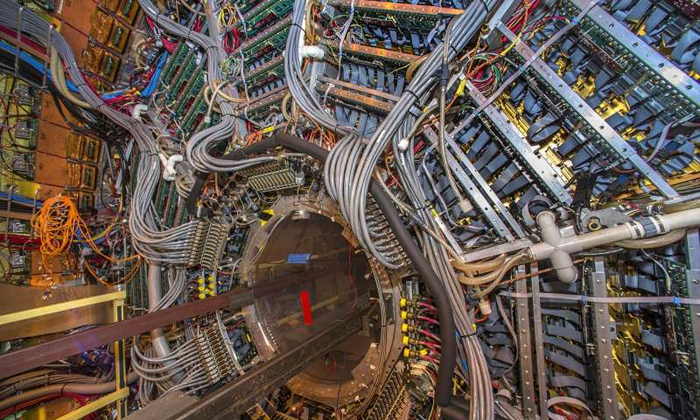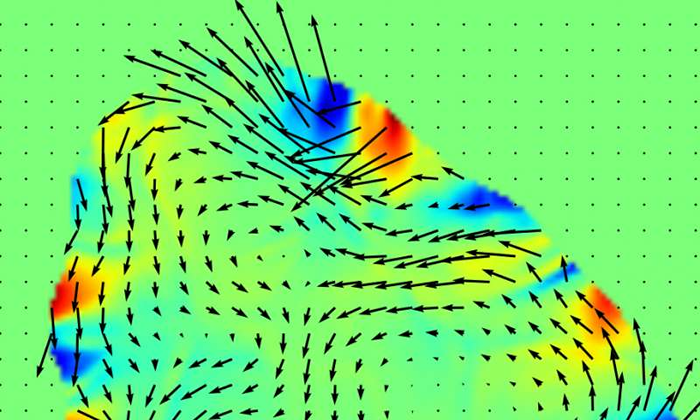Soup of the day: Origins of the universe
At its start, the universe was a superhot melting pot that very briefly served up a particle soup resembling a ‘perfect,’ frictionless fluid. Scientists have recreated this ‘soup,’ known as quark-gluon plasma, in high-energy nuclear collisions to better understand our universe’s origins and the nature of matter itself. The physics can also be relevant to neutron stars, which are the extraordinarily dense cores of collapsed stars.
Now, powerful supercomputer simulations of colliding atomic nuclei, conducted by an international team of researchers including a Berkeley Lab physicist, provide new insights about the twisting, whirlpool-like structure of this soup and what’s at work inside of it, and also lights a path to how experiments could confirm these characteristics. The work is published in the November 1st edition of Physical Review Letters.
Matter, deconstructed
This soup contains the deconstructed ingredients of matter, namely fundamental particles known as quarks and other particles called gluons that typically bind quarks to form other particles, such as the protons and neutrons found at the cores of atoms. In this exotic plasma state—which can reach trillions of degrees Fahrenheit, hundreds of thousands of times hotter than the sun’s core—protons and neutrons melt, freeing quarks and gluons from their usual confines at the center of atoms.
These record-high temperatures have been achieved by colliding gold nuclei at Brookhaven National Laboratory’s RHIC (Relativistic Heavy Ion Collider), for example, and lead nuclei at CERN’s LHC (Large Hadron Collider). Experiments at RHIC discovered in 2005 that quark-gluon plasma behaves like a fluid. In addition to gold nuclei, RHIC has also been used to collide protons, copper and uranium. The LHC began conducting heavy-ion experiments in 2014, and has confirmed that the quark-gluon plasma behaves like a fluid.
There remain many mysteries about the inner workings of this short-lived plasma state, which may only have existed for millionths of a second in the newborn universe, and nuclear physicists are using a blend of theory, simulations and experiments to glean new details about this subatomic soup.
Surprising complexity in plasma structure
“In our sophisticated simulations, we found that there is much more structure to this plasma than we realized,” said Xin-Nian Wang, a theorist in the Nuclear Science Division at Berkeley Lab who has worked for years on the physics of high-energy nuclear collisions.
When plotted out in two dimensions, the simulations found that slightly off-center collisions of heavy nuclei produce a wobbling and expanding fluid, Wang said, with local rotation that is twisted in a corkscrew-like fashion.
This corkscrew character relates to the properties of the colliding nuclei that created the plasma, which the simulation showed expanding along—and perpendicular to—the beam direction. Like spinning a coin by flicking it with your finger, the simulations showed that the angular momentum properties of the colliding nuclei can transfer spin properties to the quark gluon plasma in the form of swirling, ring-like structures known as vortices.
The simulations showed two of these doughnut-shaped vortices—each with a right-handed orientation around each direction of the separate beams of the colliding nuclei—and also many pairs of oppositely oriented vortices along the longest dimension of the plasma. These doughnut-shaped features are analogous to swirling smoke rings and are a common feature in classical studies of fluids, a field known as hydrodynamics.
The simulations also revealed a patterned outward flow from hot spots in the plasma that resemble the spokes of a wheel. The time scale covered in the simulation was infinitesimally small, Wang said, roughly the amount of time it takes light to travel the distance of 10-20 protons. During this time the wobbling fluid explodes like a fireball, spurting the particle soup outward from its middle more rapidly than from its top.
Any new understanding of quark-gluon plasma properties should be helpful in interpreting data from nuclei-colliding experiments, Wang said, noting that the emergence of several localized doughnut-like structures in the simulations was “completely unexpected.”
Unraveling a mystery
“We can think about this as opening a completely new window of looking at quark-gluon plasmas, and how to study them,” he said. “Hopefully this will provide another gateway into understanding why this quark-gluon fluid is such a perfect fluid—the nature of why this is so is still a puzzle. This work will benefit not only theory, but also experiments.”
The simulations provide more evidence that the quark-gluon plasma behaves like a fluid, and not a gas as had once been theorized. “The only way you can describe this is to have a very small viscosity,” or barely any friction, a characteristic of a so-called ‘perfect fluid’ or ‘fundamental fluid,'” Wang said. But unlike a familiar fluid like water, the simulation focuses on a fluid state hundreds of times smaller than a water molecule.
Michael Lisa, a physics professor at Ohio State University who is part of the collaboration supporting the Solenoidal Tracker at RHIC (STAR), said the so-called vorticity or “swirl structure” of this plasma has never been measured experimentally, though this latest theoretical work may help to home in on it. STAR is designed to study the formation and characteristics of the quark-gluon plasma.
“Wang and his collaborators have developed a sophisticated, state-of-the-art hydrodynamic model of the quark-gluon plasma and have identified swirling structures that vary within the fluid itself,” he said. “Even more useful is the fact that they propose a method to measure these structures in the laboratory.”
Lisa also said there is ongoing analysis work to confirm the simulation’s findings in data from experiments at RHIC and the LHC. “It is precisely innovations like this, where theory and experiment collaborate to explore new phenomena, that hold the greatest hope for greater insight into the quark-gluon plasma,” he said.
“Many tools have been used to probe the inner working mechanics and symmetry properties of this unique matter,” said Zhangbu Xu, a spokesperson for the STAR collaboration and a staff scientist at Brookhaven National Laboratory. He also said that preliminary results from STAR also suggest some spinning motion in the fluid, and the simulation work “adds a new dimension” to this possibility.
More information: Phys.org



Comments are closed, but trackbacks and pingbacks are open.